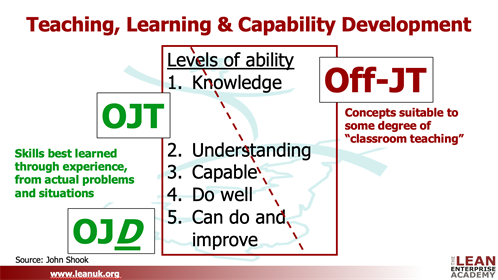Of the five dimensions John Shook identified in the Lean Transformation Framework capability development is probably the least understood and researched. We’ve posed two questions to explore this further:
- “How do organisations typically develop capability (to solve their business problems)” (not just to introduce lean.)
- “Is the way really strong lean organisations develop capability different to the way many organisations try to do it (if they do it at all?)”
“Capability Development” in the Lean Transformation Framework is all about how we develop people. Good Lean Thinking involves understanding the current condition before defining a target condition. If we want effectiveness and longevity of our lean efforts then perhaps the ultimate goal of the capability development conundrum is to “build capability so people can do and improve themselves.” We need to address both the issue of how to solve today’s problems (simple gaps from standard) and the development of future capability – solving the next generation of problems to prepare for the future.
If we borrow the old skills matrix classifications from Toyota there are a number of insights. The classification looks at ability from level 1 – having “Knowledge” through understanding, being capable, being able to do a job well through to being able to do, teach the job and improve it (see the illustration below.) Interestingly it’s really only knowledge of work that is suitable to teach in a classroom – off the job training. Levels 2 through 5 are better taught with actual problems and situations on the job with mentoring from capable superiors. You can’t develop skill just by sitting in a classroom – you have to practice.

So, to build capability we need to design processes that develop people “On the job” Developing people needs to be explicit. It’s actually each leader’s job, not a job to be abdicated to the training department or outside help. To develop people, line managers have to develop experiments – beginning from need and aiming training a level above what the organisational need is – to stretch people and the organisation. In short, capability development can be categorised in three areas: off the job training (Off-JT), on the job training (OJT) and on the job development (OJD.) The engine for such experiments is the Plan, Do Check Act cycle – the scientific method. Begin based on need, means solving real problems that help close our performance gaps.

Each category is wothy of further analysis. Toyota uses a unique set of processes that help develop capability – from the creation of do-jo areas close tot he workarea where basic skills can be taught, to the use of quality circles to develop problem awareness, problem solving and team working, through to the creation of versatility charts to visualise current skills, required skills and gaps – think of it as a “plan for every person.”
We think a gap exists between the way many organisations develop capability – often lean training revolves around certification and the awarding of belts – and the way Toyota does this. That’s why we’ve asked Toyota to open their doors and tell us specifically about these hidden processes. We can literally go to the gemba, see for ourselves these processes and how they fit together and reflect on the gaps that exist in our own capability development efforts. A worthwhile step in our own learning and development.